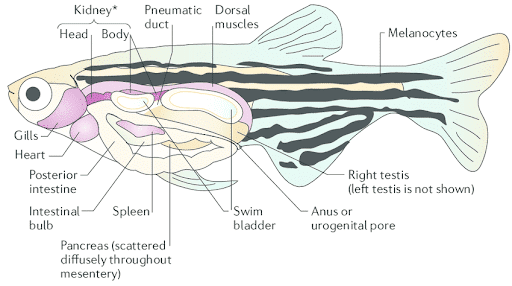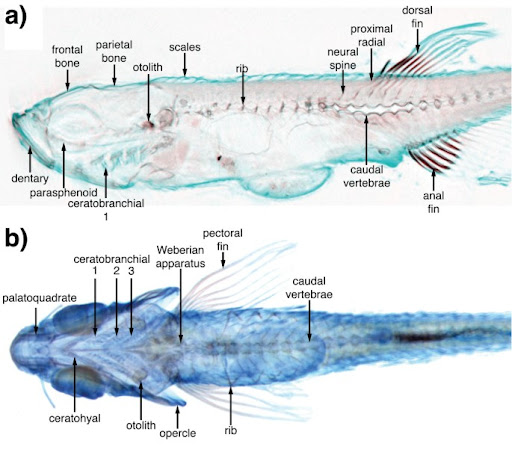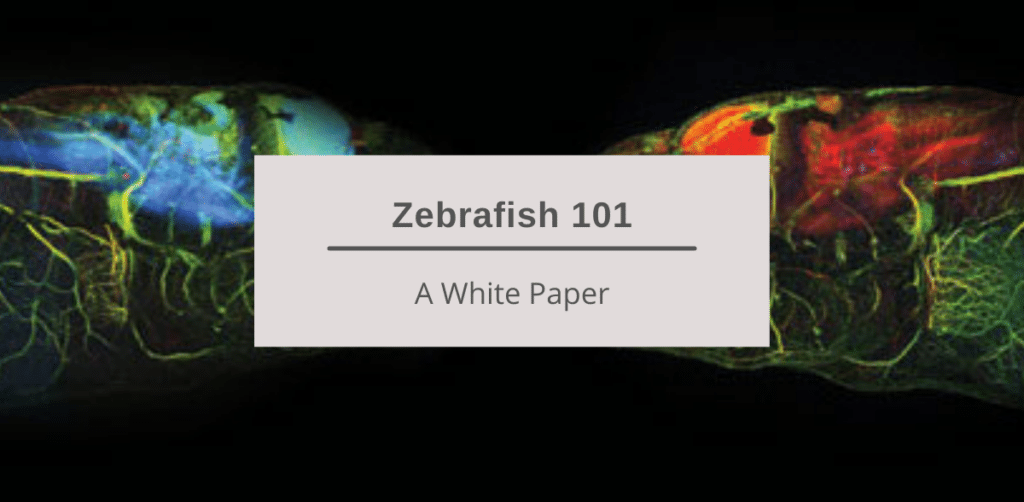Summary
From pet to model organism, zebrafish have made impressive strides since the 1960s, when George Stresinger pitched its use in research. In this white paper we will discuss the attributes of zebrafish, their advantages and limitations, and how they are currently being used in research to answer the question: is a zebrafish model right for my research?

Figure 1. Adult zebrafish (Liu, Li & Yuan, 2016).
What are zebrafish?: Biological Sketch
Zebrafish (Danio rerio, formerly known as the Brachydanio rerio) are a tropical fresh-water fish that are native to Southeast Asia, however nowadays can be found in many pet shops around the world thanks to their attractive blue horizontal stripes and their easy maintenance [See Figure 1] (Burke, 2016). Part of the minnow family, zebrafish are a small (2.5-4cm) and robust organism. Adult male and female zebrafish can be distinuished by their abdoemn size (females have larger), the color of anal fin (male’s appear more yellow), and the protrusion of the genital pore (only visable in females) (Kossack & Draper, 2019).
Origins of the Model: how did zebrafish become a model?
George Streisinger began using zebrafish in his research in the 1960s, at a time when biomedical researchers were looking for alternative, more complex, models than the phage systems they predominantly used (yourgenome, 2021). The zebrafish model’s value was quickly recognized by Streisinger’s colleagues at the University of Oregon, like Chuck Kimmel, who saw the potential for zebrafish to study the development of the nervous system (Rahman Khan & Sulaiman Alhewairini, 2018). Since then, there’s been an explosion in zebrafish research that spans many areas of study such as: developmental disorders, metabolic disorders, cancers, and toxicology (Choi, 2021).
Advantages to using the Zebrafish Model
A zebrafish model is attractive to researchers because its complexity allows for many studies that are typically conducted on mammalian models, without the high cost, large storage space, and ethical considerations (Rahman Khan & Sulaiman Alhewairini, 2018). Zebrafish mature quickly (90 days), can reproduce every 10 days, and have a large brood size (200-300 eggs per week), making them well-suited to gathering large amounts of data.
Since zebrafish are vertebrates, they have the same major organs and tissues as humans, and are an ideal model for bone-related diseases such as ostepoarthritis, osteoporosis, and Gaucher disease [Figure 3] (Valenti, Marchetto, Mottes & Dalle Carbonare, 2020). Furthermore, zebrafish embryos are laid externally, fertilized externally, and are transparent; making them easily genetically manipulated, and observed throughout development (Burke, 2016).

Figure 2. The life cycle of zebrafish (Ramcharran, 2016).

Figure 3. A 10 mm fish is shown with Alcian blue and alizarin red staining the cartilage and bone respectively (Bryson-Richardson, 2007).
Zebrafish are also strikingly genetically similar to humans, sharing 70% of all human genes (comparatively 80% of human genes have mouse orthologs), and 84% of disease genes (Choi et al., 2021). Recent advancements in next-generation sequencing technology, and CRISPR is making zebrafish an even more versatile model, as knock-in and knock-out techniques have become an available tool for zebrafish researchers. The zebrafish research community has many resources available, such as ZFIN (https://zfin.org/) which provides curated data, and ZIRC (https://zebrafish.org/home/guide.php) which offers fish lines, antibodies, and health services. The Wellcome Trust Sanger Institute’s zebrafish genome project is also an invaluable resource tool for researchers, beginning in 2001 and completed in 2013, this project fully sequenced the zebrafish genome (yourgenome, 2021).
Limitations to the Zebrafish Model
Despite the zebrafishes’ versatility, there are some areas of research where they are not the most apt model: for instance, human diseases in a tissue or organ that don’t have an equivalent in zebrafish (prostrate, mammary glands, lungs). Their habitat can also pose difficulty for certain experiments, as zebrafish are aquatic animals (Burke, 2016).
Zebrafish & the Nobel Prize
After Stresigner began advocating for the zebrafish model it was adopted by researchers worldwide; one of those researchers was Dr Nüsslein-Volhard. While her collaborators mainly used fruit fly models, Nüsslein-Volhard decided to study the flies in conjunction with zebrafish. Her work on the genetic control of embryogenesis earned her, Dr Lewis, and Dr Wieschaus, the Nobel Prize for Physiology and Medicine in 1995 (Resnik & May, 2012).
Dr Nüsslein-Volhard’s research journey is exemplary of how powerful a multi-model approach to research can be, particularly when pairing a complex model like zebrafish with a more simplistic organism.
Recent & Notable Publications Using Zebrafish
Recent & Notable Publications using zebrafish to study toxicology
- Zebrafish: An emerging model to study microplastic and nanoplastic toxicity
- The Rise of Zebrafish as a Model for Toxicology
- Zebrafish as screening model for detecting toxicity and drugs efficacy
Recent & Notable Publications using zebrafish to study metabolic disorders
- The promise of zebrafish as a model of metabolic syndrome
- The use of zebrafish (Danio rerio) as biomedical models
- Obese zebrafish: A small fish for a major human health condition
Recent & Notable Publications using zebrafish to study bone diseases (osteo-s)
- Zebrafish Models of Human Skeletal Disorders: Embryo and Adult Swimming Together
- Zebrafish as an Emerging Model for Osteoporosis: A Primary Testing Platform for Screening New Osteo-Active Compounds
- Skeletal Biology and Disease Modeling in Zebrafish
Recent & Notable Publications using zebrafish to study cancers
- Zebrafish: Speeding Up the Cancer Drug Discovery Process
- Zebrafish Models of Cancer-New Insights on Modeling Human Cancer in a Non-Mammalian Vertebrate
- Zebrafish patient avatars in cancer biology and precision cancer therapy
Recent & Notable Publications using zebrafish to study neurodevelopmental and neurodegenerative disorders
- Zebrafish as a Model of Neurodevelopmental Disorders
- Zebrafish: an emerging real-time model system to study Alzheimer’s disease and neurospecific drug discovery
- Zebrafish Models of Neurodevelopmental Disorders: Limitations and Benefits of Current Tools and Techniques
References
- Bryson-Richardson, R.J., Berger, S., Schilling, T.F. et al. (2007). FishNet: an online database of zebrafish anatomy . BMC Biol 5, 34https://doi.org/10.1186/1741-7007-5-34
- Burke, Elizabeth (2016). Why Use Zebrafish to Study Human Diseases? NIH: Intramural Research Program, blog. https://irp.nih.gov/blog/post/2016/08/why-use-zebrafish-to-study-human-diseases
- Choi, TY., Choi, TI., Lee, YR. et al. (2021). Zebrafish as an animal model for biomedical research. Nature: Exp Mol Med 53, 310-317 https://doi.org/10.1038/s12276-021-00571-5
- Kossack, M. E., & Draper, B. W. (2019). Genetic regulation of sex determination and maintenance in zebrafish (Danio rerio). Current topics in developmental biology, 134, 119-149. https://doi.org/10.1016/bs.ctdb.2019.02.004
- Liu, Y., Li, D., & Yuan, Z. (2016). Photoacoustic Tomography Imaging of the Adult Zebrafish by Using Unfocused and Focused High-Frequency Ultrasound Transducers. Applied Sciences, 6(12), 392. MDPI AG. Retrieved from http://dx.doi.org/10.3390/app6120392
- Rahman Khan, F. & Sulaiman Alhewairini, S., (2018). Zebrafish (Danio rerio) as a Model Organism. IntechOpen. DOI: 10.5772/intechopen.81517
- Ramcharran, Sara. (2016). The Why and How of Breeding Zebrafish for Research. Owlcation. https://owlcation.com/stem/The-why-and-how-of-breeding-zebrafish-for-research
- Resnik, Jack,, May, Catherine, “Christiane Nusslein-Volhard (1942- )”. Embryo Project Encyclopedia (2012-02-16). ISSN: 1940-5030 http://embryo.asu.edu/handle/10776/7901.
- Valenti, M.T., Marchetto, G., Mottes, M. & Dalle Carbonare, L. (2020). Review: Zebrafish: A Suitable Tool for the Study of Cell Signaling in Bone. cells. https://www.mdpi.com/2073-4409/9/8/1911
Harness the power of zebrafish toxicity testing for reliable and efficient evaluation of chemical safety. Contact us today to unlock the potential of this cutting-edge approach and make informed decisions that prioritize safety in your research and development endeavors.



